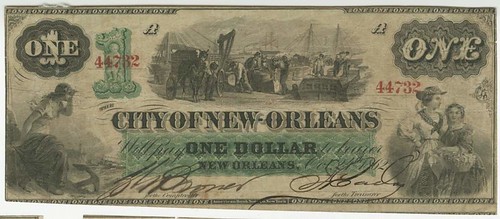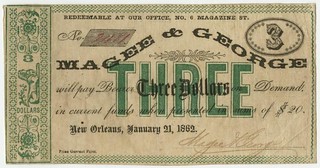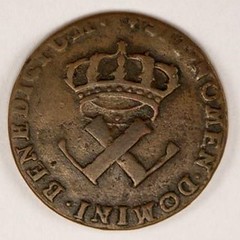
PREV ARTICLE
NEXT ARTICLE
FULL ISSUE
PREV FULL ISSUE
HISTORIC NEW ORLEANS COLLECTION MONEY EXHIBIT
The article from the New Orleans Advocate describes a new numismatic-themed exhibit at the Historic New Orleans Collection museum.
-Editor
The Historic New Orleans Collection has more than 200 old notes and coins on display for its “Money! Money! Money!” exhibit in the Williams Research Center at 410 Chartres St. The free exhibit, running through Oct. 29, includes an interactive bingo-style dollar hunt. And, a staff member is available to help inquisitive visitors navigate the impressive collection.
Elaborate banknotes from the antebellum period make up much of the collection, Greenwald said. There was a boom in new currency as new cities were settled on the Western frontier. The diversity among bills in circulation also made counterfeiting easier, as people were more likely to mistake an unfamiliar banknote forgery from a far away city. Counterfeit detecting handbooks were used by cashiers to assist with the identification of fakes, but of course, these manuals also helped counterfeiters perfect their forgeries. The imagery on the bills, selected by bank officers, changed often in an attempt to outpace counterfeiters. The depictions chosen provide insight into the culture that produced them. Bills often would feature scenes of commerce and local culture. New Orleans banknotes, for example, showed images of ports, rivers and boats. When the Confederate States of America began printing currency, the notes promoted Confederate ideology with references to the domestic slave trade. 
Currency remained decentralized throughout the Civil War and up until the passage of the National Banking Acts of 1863 and 1864, which gave the federal government jurisdiction over banking. These acts prohibited nonfederal banks from issuing coins and taxed them for issuing banknotes. “Money! Money! Money!” concludes its presentation of early U.S. banking with some of the first federal banknotes, the predecessors of modern U.S. dollar bills. The arrival of these “demand notes” heralded the end of state and local currencies, which were discontinued in response to the new tax. For more information on the exhibit, see:
THE BOOK BAZARREWayne Homren, Editor The Numismatic Bibliomania Society is a non-profit organization promoting numismatic literature. See our web site at coinbooks.org. To submit items for publication in The E-Sylum, write to the Editor at this address: whomren@gmail.com To subscribe go to: https://my.binhost.com/lists/listinfo/esylum All Rights Reserved. NBS Home Page Contact the NBS webmaster 
|

